Boolean Algebra is a mathematical way of representing combinational logic circuits made from logic gates. The identities and theorems of Boolean Algebra allow complex logic circuits to be simplified.
Browser check: This bold uppercase A should have a line above it and this bold uppercase B should have two lines above it. If the lines are not there, this page is not going to work. If you can see an A with a line above it and a B with a double line, read on ...
The AND function is represented by a DOT like the product symbol sometimes used in mathematics

The OR function is represented by a PLUS like the addition symbol used in mathematics

The NOT function is represented by a BAR above the symbol

The NAND function is a combination of the DOT for the AND and a BAR for the NOT. The BAR is over the DOT and includes both inputs

The NOR function is a combination of the PLUS for the OR and a BAR for the NOT. The BAR is over the PLUS and includes both inputs

Logic circuits can be described using Boolean algebra. The aim is to express Q in terms of A and B

Therefore:

Therefore:

Therefore:

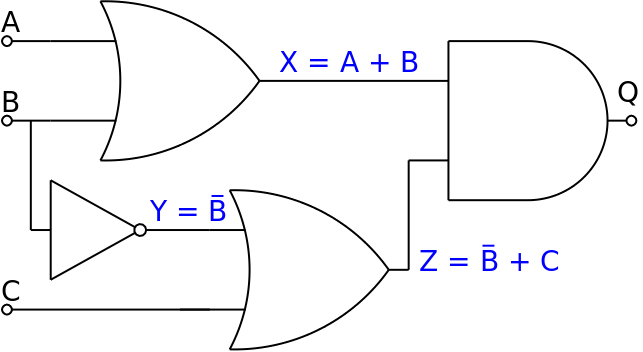
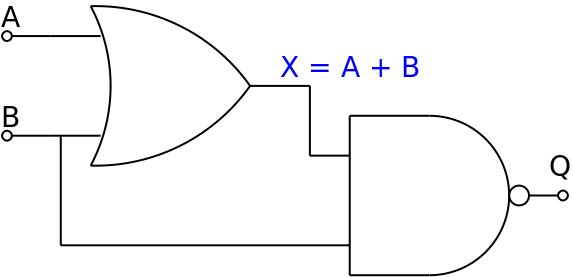
Truth tables can be represented using Boolean algebra. For each row where Q = 1 there is a Boolean expression. If more that one row has Q = 1 then the individual Boolean expressions are combined with the Logic OR function.
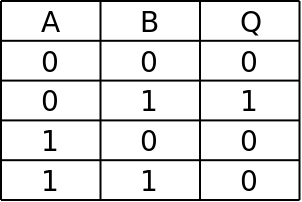 There is only one row where Q = 1 which is when A = 0 and B = 1
There is only one row where Q = 1 which is when A = 0 and B = 1
Alternatively, there is only one row where Q = 1 which is when A = 1 and B = 1
This can be expressed as Q = 1 when A = 1 AND B = 1 which is written as Q = A . B
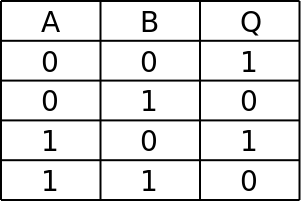 There are two rows where Q = 1 which are when A = 0 and B = 0 or when A = 1 and B = 0
There are two rows where Q = 1 which are when A = 0 and B = 0 or when A = 1 and B = 0
Alternatively, there are two rows when Q = 1 which are when A = 1 and B = 1 or when A = 1 and B = 1
This can be expressed as Q = 1 when (A = 1 AND B = 1) OR (A = 1 AND B = 1) which is written as Q = (A . B) + (A . B)
 There are two rows where Q = 1 which are when A = 0 and B = 0 or when A = 0 and B = 1
There are two rows where Q = 1 which are when A = 0 and B = 0 or when A = 0 and B = 1
Alternatively, there are two rows when Q = 1 which are when A = 1 and B = 1 or when A = 1 and B = 1
This can be expressed as Q = 1 when (A = 1 AND B = 1) OR (A = 1 AND B = 1) which is written as Q = (A . B) + (A . B)
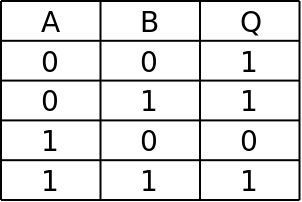 By considering each row where Q = 1 the truth table can be represented as:
By considering each row where Q = 1 the truth table can be represented as:
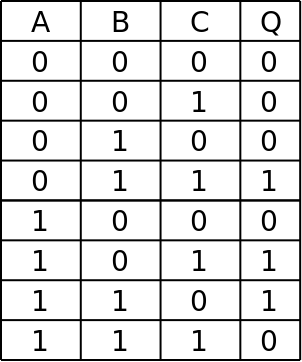 The same principle applies when there are three inputs (or more). Consider each row where Q = 1 and combine the Boolean expressions with Logical OR functions (+)
The same principle applies when there are three inputs (or more). Consider each row where Q = 1 and combine the Boolean expressions with Logical OR functions (+)
By considering each row where Q = 1 the truth table can be represented as:

Each of the above identities can be shown to be correct by considering the truth table for the AND function. In the identities A is a variable and can be either Logic 0 or Logic 1
Consider the case when A = 0
The four identities can now be written as:
0 . 0 = 0 which reads as "zero AND zero equals zero"
0 . 1 = 0
0 . 0 = 0
0 . 1 = 0
all of which agree with the truth table.
Consider the case when A = 1
The four identities can now be written as
1 . 0 = 0 which reads as "one AND zero equals zero"
1 . 1 = 1
1 . 1 = 1
1 . 0 = 0
all of which agree with the truth table.
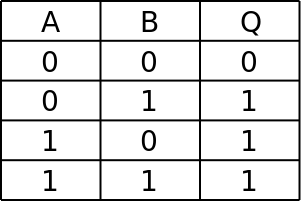
Each of the following identities can be shown to be correct by considering the truth table for the OR function. In the identities A is a variable and can be either Logic 0 or Logic 1
Consider the case when A = 0
The four identities can now be written as:
0 + 0 = 0 which reads as "zero OR zero equals zero"
0 + 1 = 1
0 + 0 = 0
0 + 1 = 1
all of which agree with the truth table.
Consider the case when A = 1
The four identities can now be written as:
1 + 0 = 1 which reads as "one OR zero equals one"
1 + 1 = 1
1 + 1 = 1
1 + 0 = 1
all of which agree with the truth table.
There is only one NOT identity. A NOT followed by another NOT has no effect. The symbol is a double bar above the character.
This reads as NOT NOT A equals A. Consider when A = 0 and so NOT A equals one, A = 1 and therefore NOT (NOT A) is zero, A = 0 giving A = A. A similar argument applies when A = 1.
DeMorgan's Theorem(s) are particularly important because they relate the (N)OR function and the (N)AND function and allow one to be equated to the other.
This reads as (NOT A) AND (NOT B) is the same as A NOR B. It is easy to prove this relationship with a truth table.
This reads as (NOT A) OR (NOT B) is the same as A NAND B. Again, this can be verified with a truth table.
© Paul Nicholls
Jan 2019

Electronics Resources by Paul Nicholls is licensed under a Creative Commons Attribution 4.0 International License.